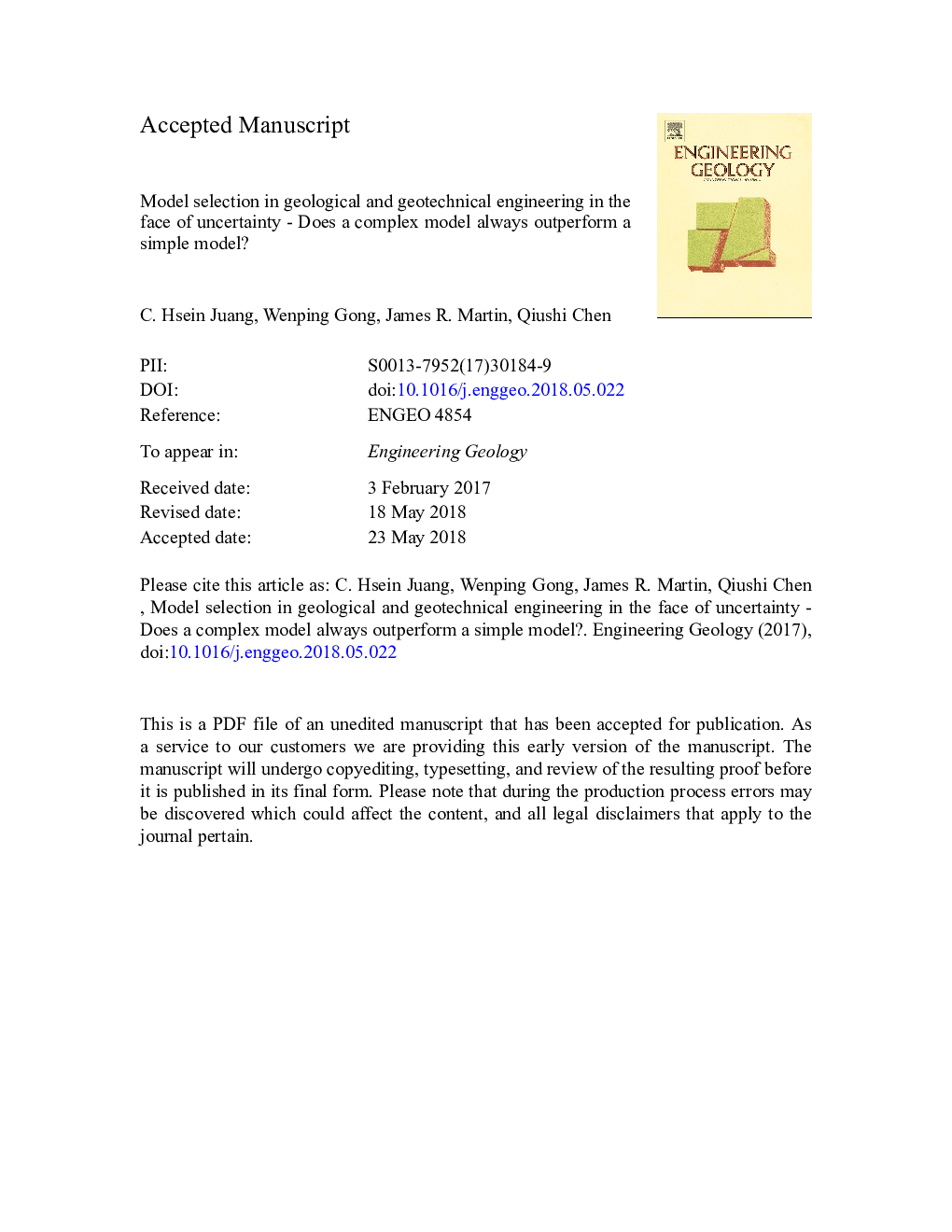| کد مقاله | کد نشریه | سال انتشار | مقاله انگلیسی | نسخه تمام متن |
|---|---|---|---|---|
| 8915834 | 1641743 | 2018 | 64 صفحه PDF | دانلود رایگان |
عنوان انگلیسی مقاله ISI
Model selection in geological and geotechnical engineering in the face of uncertainty - Does a complex model always outperform a simple model?
ترجمه فارسی عنوان
انتخاب مدل در مهندسی زمین شناسی و ژئوتکنیک در مواجهه با عدم اطمینان - آیا یک مدل پیچیده همیشه از یک مدل ساده فراتر می رود؟
دانلود مقاله + سفارش ترجمه
دانلود مقاله ISI انگلیسی
رایگان برای ایرانیان
کلمات کلیدی
انتخاب مدل، عدم قطعیت، اتصالات چندجملهای، خصوصیات سایت، شفت دریچه، حفاری بریده،
ترجمه چکیده
به منظور دستیابی به وفاداری بالاتر (به عنوان مثال، دقت بالاتر) در پیش بینی مدل، مدل های راه حل مورد استفاده در مهندسی زمین شناسی و / یا مهندسی ژئوتکنیک پیچیده و پیچیده می شوند. با این حال، مدل های ساده و قوی توسط مهندسان در عمل ترجیح داده می شود. بنابراین، بین انتخاب یک مدل پیچیده برای وفاداری و یک مدل ساده برای استحکام بالا، معضلی وجود دارد (به عنوان مثال، تغییرات پایین در اختلاف بین پیش بینی مدل و مشاهده). این مسئله زمانی عمیق تر می شود که پارامترهای مدل نااطمینانی را نشان می دهند که در مشکلات زمین شناسی و ژئوتکنیک بسیار رایج است. در این مقاله، مسئله انتخاب مدل در مواجهه با عدم قطعیت با سه مشکل بررسی می شود: انتخاب نظم متناسب با چند جمله ای (یعنی نظم پایین تر نسبت به نظم بالاتر) در توسعه مدل تجربی مبتنی بر داده ها، انتخاب از سطح پیچیدگی (به عنوان مثال، متغیر تصادفی در مقابل میدان تصادفی) در خصوصیات احتمالی خاک خالص خاک و انتخاب سطح پیچیدگی (به عنوان مثال ساده و پیچیده) مدل سازنده خاک در مدل سازی عددی. نتایج نشان می دهد که اگر چه مدل های پیچیده و پیشرفته می توانند پیش بینی های دقیق تر را انجام دهند، اما مدل های ساده می توانند پیش بینی های بیشتری را ارائه دهند. این مقاله یک بینش در مورد سوال ارائه می دهد، آیا یک مدل پیچیده همیشه یک مدل ساده را بهتر از آن می کند؟
موضوعات مرتبط
مهندسی و علوم پایه
علوم زمین و سیارات
مهندسی ژئوتکنیک و زمین شناسی مهندسی
چکیده انگلیسی
In order to achieve higher fidelity (i.e., higher accuracy) in the model predictions, the solution models employed in geological and/or geotechnical engineering are becoming complex and sophisticated. However, simple and robust models are preferred by engineers in practice. Thus, a dilemma exists between the choice of a complex model for fidelity and that of a simple model for high robustness (i.e., lower variation in the discrepancy between model prediction and observation). This issue becomes more profound when model parameters exhibit uncertainty, which is quite common in geological and geotechnical problems. In this paper, we examine the issue of model selection in the face of uncertainty with three problems: the selection of the order of polynomial fit (i.e., lower order vs. higher order) in the development of data-driven empirical model, the selection of the level of sophistication (i.e., random variable vs. random field) in the probabilistic characterization of the detrended soil property, and the selection of the level of complexity (i.e., simple vs. complex) of the soil constitutive model in numerical modelling. The results illustrate that although the complex and sophisticated models could yield predictions that are more accurate, the simple models might yield predictions that are more robust. This paper provides an insight regarding the question, “Does a complex model always outperform a simple model?”
ناشر
Database: Elsevier - ScienceDirect (ساینس دایرکت)
Journal: Engineering Geology - Volume 242, 14 August 2018, Pages 184-196
Journal: Engineering Geology - Volume 242, 14 August 2018, Pages 184-196
نویسندگان
C. Hsein Juang, Wenping Gong, James R. II, Qiushi Chen,
